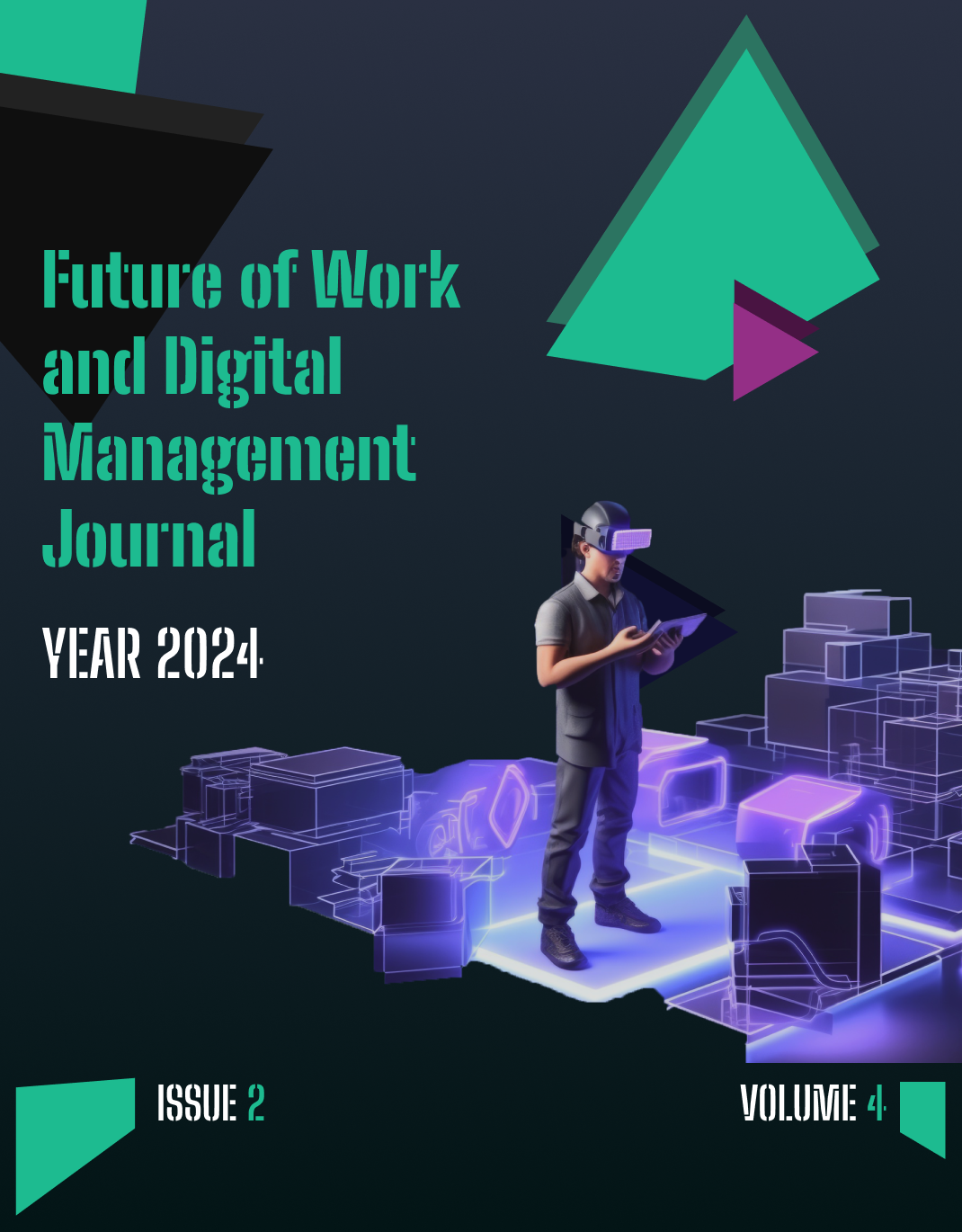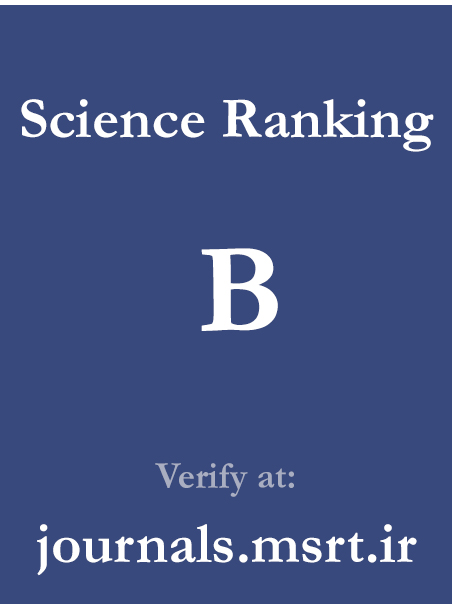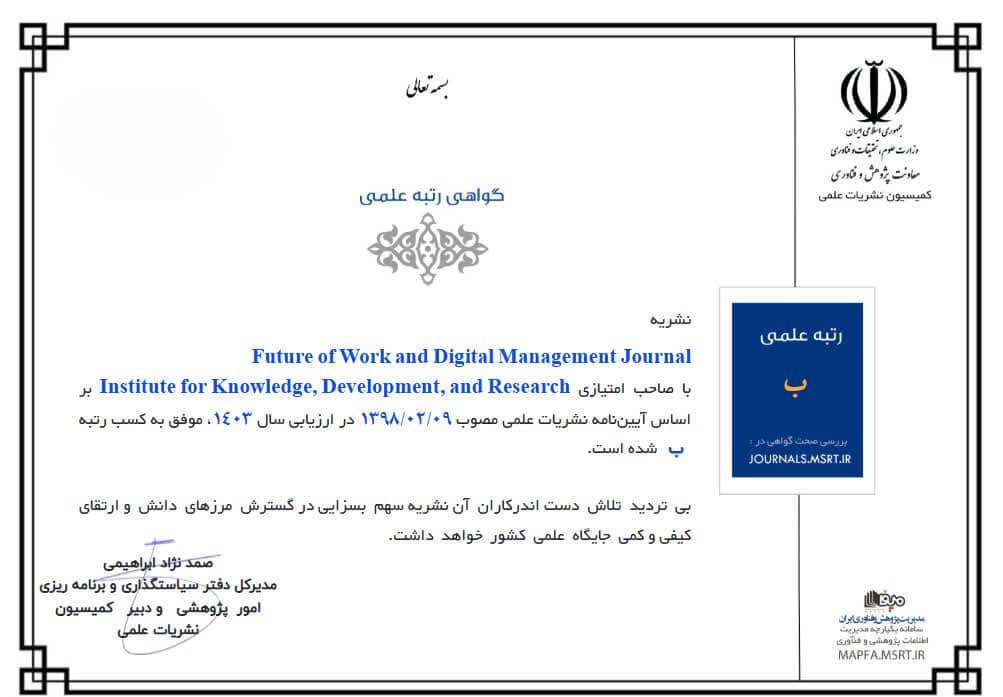Providing a Model for Assessing the Implementation and Deployment of Artificial Intelligence in the Banking Industry
Keywords:
Artificial Intelligence, Assessment, Implementation, Banking IndustryAbstract
Artificial intelligence (AI) technology, through its self-learning algorithms, has played a significant role in enhancing banking processes. By reducing human resource costs, analyzing data, and identifying patterns, this technology has assisted policymakers in achieving organizational objectives. Despite these advantages, a precise evaluation and the provision of adequate infrastructure prior to its implementation in banks, particularly in developing countries, is essential. In Iranian banks, due to infrastructural weaknesses, the successful execution of AI has been challenging, necessitating technological and organizational preparations to minimize issues of incompatibility and rising costs. This study employs a mixed-methods (quantitative and qualitative) research design. The expert community for the qualitative phase consisted of 18 individuals selected via purposive snowball sampling. For the quantitative phase, involving factor analysis, a sample of 342 specialists was selected using Cochran's sampling formula. Questionnaire reliability for the factor analysis was assessed using Cronbach's alpha coefficient and SPSS software. In the qualitative phase, 34 factors were initially extracted from prior literature using a content analysis approach. These were then refined to 27 factors through a three-round Fuzzy Delphi process based on expert opinion. Subsequently, these confirmed factors were structured into indicators and sub-indicators using Exploratory Factor Analysis (EFA) with specialist input. Finally, Confirmatory Factor Analysis (CFA) was applied to formulate structural equations and validate the final model. The indicators, ranked by order of importance based on standardized coefficients, are: Data Management and Infrastructure (0.90), AI Systems and Algorithms (0.84), Customer Experience and Interaction (0.76), Security and Risk Management (0.73), and Business Process and Optimization (0.53).
Downloads
References
[1] D. K. Nguyen, G. Sermpinis, and C. Stasinakis, "Big data, artificial intelligence and machine learning: A transformative symbiosis in favour of financial technology," European Financial Management, vol. 29, no. 2, pp. 517-548, 2023, doi: 10.1111/eufm.12365.
[2] M. Doumpos, C. Zopounidis, D. Gounopoulos, E. Platanakis, and W. Zhang, "Operational research and artificial intelligence methods in banking," European Journal of Operational Research, vol. 306, no. 1, pp. 1-16, 2023, doi: 10.1016/j.ejor.2022.04.027.
[3] S. Tripathi, R. Garg, and K. Varshini, "Role of Artificial Intelligence in The Banking Sector," 2022.
[4] N. S. A. Polireddi, "An effective role of artificial intelligence and machine learning in banking sector," Measurement: Sensors, vol. 33, p. 101135, 2024, doi: 10.1016/j.measen.2024.101135.
[5] S. Umamaheswari and A. Valarmathi, "Role of Artificial Intelligence in The Banking Sector," Journal of Survey in Fisheries Sciences, vol. 10, no. 4S, pp. 2841-2849, 2023.
[6] N. J. Dewasiri, K. S. S. N. Karunarathne, S. Menon, P. G. S. A. Jayarathne, and M. S. H. Rathnasiri, "Fusion of Artificial Intelligence and Blockchain in the Banking Industry: Current Application, Adoption, and Future Challenges," in Transformation for Sustainable Business and Management Practices: Exploring the Spectrum of Industry 5.0, 2023, pp. 293-307.
[7] M. Sankar, S. Deivasigamani, S. D. Khan, S. Pradeepa, O. Prakash, and L. Janaki, "Artificial Intelligence as a Game Changer Tool to Reshape the Banking Services in Digital Transformation," 2023, doi: 10.52783/eel.v13i5.915.
[8] M. Paramesha, N. L. Rane, and J. Rane, "Artificial intelligence, machine learning, deep learning, and blockchain in financial and banking services: A comprehensive review," Partners Universal Multidisciplinary Research Journal, vol. 1, no. 2, pp. 51-67, 2024, doi: 10.2139/ssrn.4855893.
[9] R. Sawwalakhe, S. Arora, and T. P. Singh, "Opportunities and Challenges for Artificial Intelligence and Machine Learning Applications in the Finance Sector," in Advanced Machine Learning Algorithms for Complex Financial Applications, 2023, pp. 1-17.
[10] D. Skandali, A. Magoutas, and G. Tsourvakas, "Artificial Intelligent Applications in Enabled Banking Services: The Next Frontier of Customer Engagement in the Era of ChatGPT," Theoretical Economics Letters, vol. 13, no. 05, pp. 1203-1223, 2023, doi: 10.4236/tel.2023.135066.
[11] S. P. S. Ho and M. Y. C. Chow, "The role of artificial intelligence in consumers' brand preference for retail banks in Hong Kong," Journal of Financial Services Marketing, pp. 1-14, 2023, doi: 10.1057/s41264-022-00207-3.
[12] U. Noreen, A. Shafique, Z. Ahmed, and M. Ashfaq, "Banking 4.0: Artificial intelligence (AI) in banking industry & consumer's perspective," Sustainability, vol. 15, no. 4, p. 3682, 2023, doi: 10.3390/su15043682.
[13] R. R. Lin and J. C. Lee, "The supports provided by artificial intelligence to continuous usage intention of mobile banking: evidence from China," Aslib Journal of Information Management, 2023, doi: 10.1108/AJIM-07-2022-0337.
[14] A. Todupunuri, "The Role of Artificial Intelligence in Enhancing Cybersecurity Measures in Online Banking Using AI," International Journal of Enhanced Research in Management & Computer Applications, vol. 12, no. 01, pp. 103-108, 2023, doi: 10.55948/ijermca.2023.01015.
[15] D. Verma and Y. Chakarwarty, "Impact of bank competition on financial stability-a study on Indian banks," Competitiveness Review: An International Business Journal, 2023, doi: 10.1108/CR-07-2022-0102.
[16] T. A. Abdulsalam and R. B. Tajudeen, "Artificial Intelligence (AI) in the Banking Industry: A Review of Service Areas and Customer Service Journeys in Emerging Economies," BMC, vol. 68, no. 3, pp. 19-43, 2024, doi: 10.56065/9hfvrq20.
[17] M. R. Gupta, "Revolutionizing Finance: The Unleashing Power of Artificial Intelligence in the Banking Sector," International Scientific Journal of Engineering and Management, vol. 03, no. 04, pp. 1-9, 2024, doi: 10.55041/isjem01663.
[18] A. Saberian Jahromi, "Investigating the Impact of Artificial Intelligence in the Banking Sector," in Ninth International Conference on Management, Economics, and Industry-oriented Accounting Studies, Tehran, 2024. [Online]. Available: https://civilica.com/doc/2037732/.
[19] M. Rahman, T. H. Ming, T. A. Baigh, and M. Sarker, "Adoption of artificial intelligence in banking services: an empirical analysis," International Journal of Emerging Markets, vol. 18, no. 10, pp. 4270-4300, 2023, doi: https://doi.org/10.1108/IJOEM-06-2020-0724.
[20] R. Meena, A. K. Mishra, and R. K. Raut, "Strategic insights: mapping the terrain of artificial intelligence (AI) in banking through mixed method approach," VINE Journal of Information and Knowledge Management Systems, vol. ahead-of-print, no. ahead-of-print, 2024, doi: 10.1108/VJIKMS-01-2024-0028.
[21] C. A. Shah, "A Bibliometric Analysis of Artificial Intelligence in the Banking Sector: Trends, and Future Directions," Cana, vol. 32, no. 8s, pp. 252-270, 2025, doi: 10.52783/cana.v32.3669.
[22] M. Klimontowicz, "Artificial Intelligence in Banking : The Evidence From Poland," Icair, vol. 4, no. 1, pp. 194-202, 2024, doi: 10.34190/icair.4.1.3197.
[23] R. Mahmoudi Alashti, H. Jalali Atashgah, and A. Iyuzi, "Application of Artificial Intelligence in Central Banking: Impacts and Results of AI Utilization in Central Banks," in Sixth International Conference on Key Research in Management, Accounting, Banking, and Economics, Mashhad, 2024. [Online]. Available: https://civilica.com/doc/2058788/.
[24] M. Jalali Filshour, H. Alizadeh, and S. Shahryari, "Presenting a value co-creation model in banking and insurance with an emphasis on artificial intelligence tools and using a hybrid approach," in 31st National Conference and 12th International Conference on Insurance and Development: Public Satisfaction and Trust in the Insurance Industry, 2025, vol. 1, 18 ed. [Online]. Available: https://civilica.com/doc/2148845.
Downloads
Published
Submitted
Revised
Accepted
Issue
Section
License
Copyright (c) 2024 Leila Mollaei , Seyyed Mohammad Ali Khatami Firoozabadi, Kiamars Fathi Hafshejani , Mahnaz Rabiei (Author)

This work is licensed under a Creative Commons Attribution-NonCommercial 4.0 International License.








